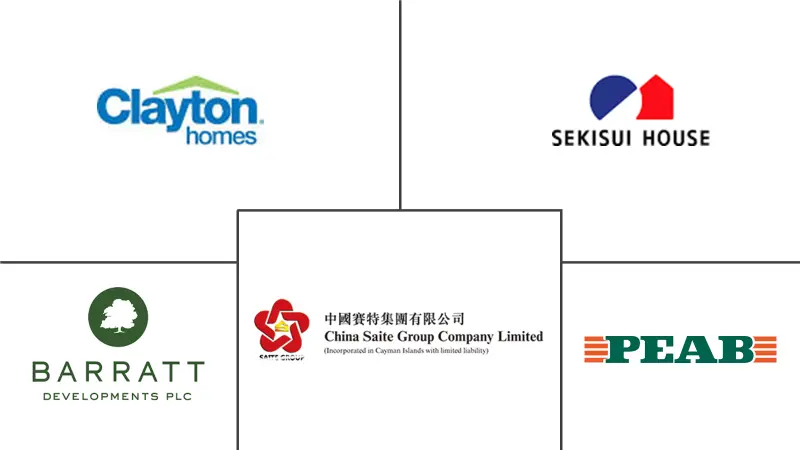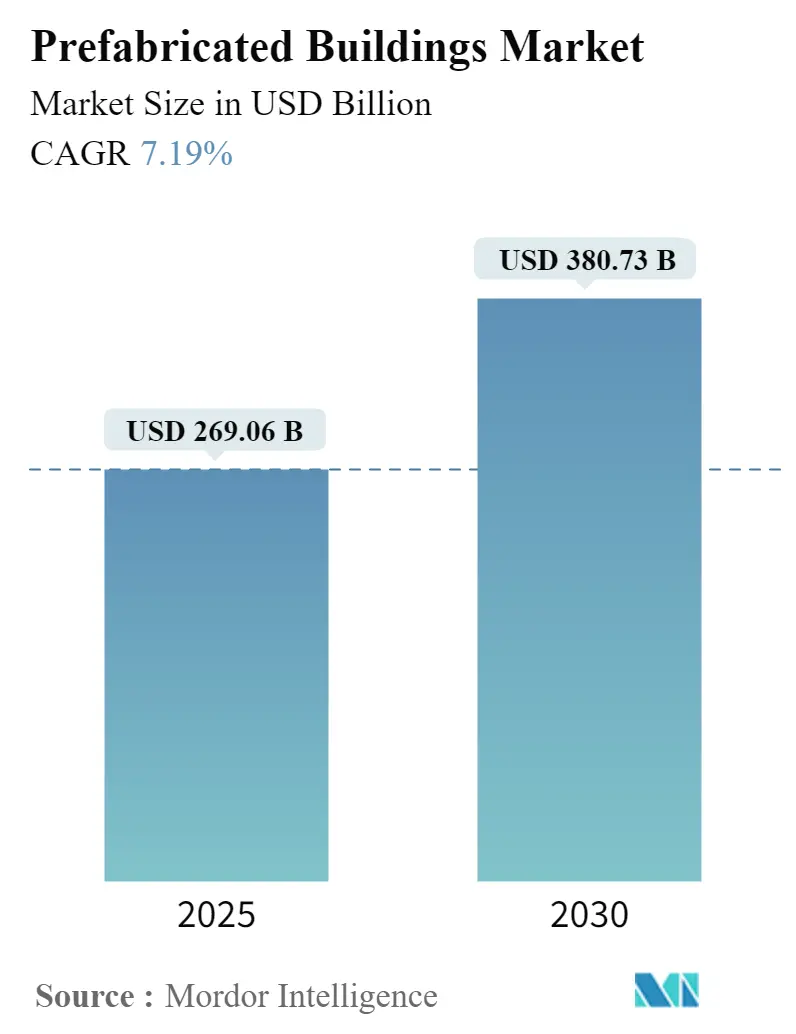
Prefabricated Buildings Market Analysis by Mordor Intelligence
The Prefabricated Buildings Market size is estimated at USD 269.06 billion in 2025, and is expected to reach USD 380.73 billion by 2030, at a CAGR of 7.19% during the forecast period (2025-2030).
All construction-related operations worldwide stopped due to the COVID-19 pandemic and consequent lockdowns. As a result, modular construction projects in various construction segments, such as educational, residential, airports, and others, had decreased, thus significantly impacting demand for prefabricated buildings. In several places, the supply chain had also been interrupted, thus causing a delay in the delivery of construction material required and affecting the construction activities.
The adoption of additive manufacturing in Europe is expected to significantly boost the prefabricated construction sector. Companies are embracing eco-friendly products and production practices to set themselves apart from the competition. The introduction of energy-absorbing materials such as micro dwellings resulted from the focus on energy efficiency.
Another major factor driving market expansion in the region, particularly in Switzerland, the Nordics, and the United Kingdom, is the introduction of turnkey solutions. Germany, the Nordic countries, and the United Kingdom dominate the prefabricated building industry in Europe.
The United Kingdom is a prospective market for prefabricated building companies. The major players are investing in improved performance and productivity to capitalize on the market's growth potential and modular construction approaches. The existing shortage of skilled labor in the construction industry is a crucial element sustaining the United Kingdom's position in the European prefabricated building industry.
Prefab enterprises have a huge opportunity in India, where there is a need for hundreds or thousands more plants in the future. India is anticipated to be among the fastest-growing countries in terms of construction output over the next few years, making technology a critical component.
India is projected to be the world's second-largest building market in the next five years. A continued government push for digitalization and the adoption of cutting-edge construction technology like BIM is a key driver for the adoption of prefabricated buildings. Government efforts such as "Digital India," "Housing for All," and "Bharatmala Pariyojana" have boosted the use of prefabricated buildings in India.
The value of prefabricated buildings imported into Spain increased significantly in 2022. From 2003 to 2007, the imports of these products increased until they were valued at EUR 101 million(USD 109.78 Million). After that, those imports had a downward trend, reaching EUR 36 million(USD 39.13 Million) in 2012. The prefabricated buildings imported in 2021 into Spain were valued at EUR 65 million(USD 70.65 Million).
Global Prefabricated Buildings Market Trends and Insights
Growing demand for Modular Construction
Due to rapid economic development in developing nations and historically low interest rates in many wealthy nations, there is a rising demand for construction. Along with this, the market is anticipated to rise throughout the forecast period due to factors like rising disposable income, technological advancements, and increased private-sector investments in construction. Additionally, greater spending on housing and infrastructure by governments around the world is boosting market expansion. Time and cost are two factors related to building operations that have long been viewed as a barrier to the industry's expansion in many emerging economies. Overcoming this restriction has been one of the main challenges for many significant building enterprises across the world. The prefabricated building system is one of the primary remedies for these issues.
Prefabricated building technologies can reduce construction time by 30 to 50 percent in today's market and provide an alternative. Since fewer workers are needed for the on-site procedures, the system is economical. Another unintended consequence of the process is reduced on-site activity is the significantly smaller amount of garbage that is generated. Because of these benefits, prefabricated building system activities are growing in popularity in the construction sector.
In nations like Singapore and India, where governments are investing extensively in boosting the building and construction sector, business is booming. The Australian Trade and Investment Commission estimates that Singapore spends at least USD 2 billion a month on public infrastructure. Additionally, the Dutch construction industry is growing thanks to the government's program for a circular economy, which aims to create a circular economy in the country by 2050. Furthermore, due to different government efforts like Foreign Direct Investments, the building and construction industries are also expanding.
Prefabricated building systems are widely employed in the construction of both residential and non-residential structures because they have several advantages, including being environmentally friendly and flexible, causing less site disruption, and cost savings. Therefore, it is anticipated that demand for prefabricated building systems like ventilated thermal panels will expand significantly as construction activity increases globally. As a result, such government initiatives and investments in the building sector serve as a market driver.
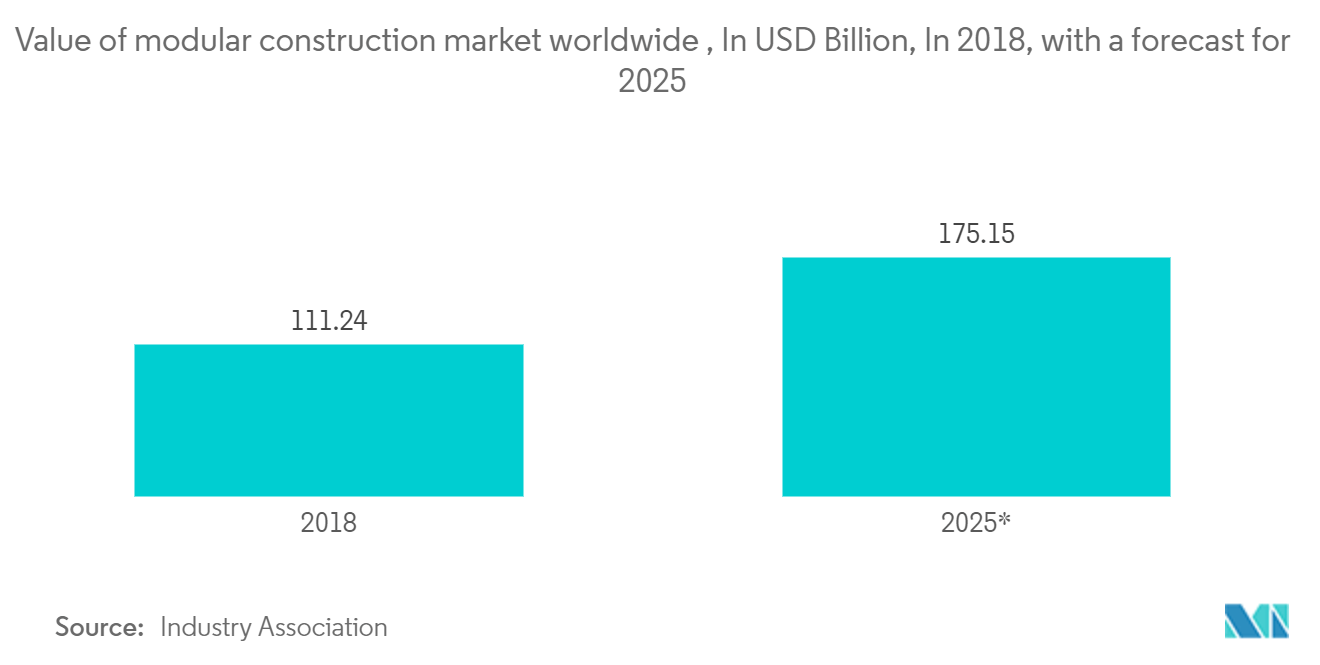
Asia-Pacific is Projected to Witness Highest Growth in the Market
The Asia-Pacific prefabricated buildings market is estimated to witness the highest growth over the next five years. The prefabricated construction market in Japan is comparatively mature and developed compared to other regions of the world.
The demand for cheap housing is one of the main factors driving the market. Prefabricated houses can be a practical answer to the issue of a lack of cheap housing in several Asian and Pacific Island nations. Prefabricated structures can be built more rapidly and are typically less expensive than traditional buildings, which can help bring down the cost of construction.
The growth in construction activity is another significant aspect influencing the industry. Recent years have seen significant urbanization in the Asia Pacific region, which has increased construction activity. Residential, commercial, and industrial development projects can all benefit from the utilization of prefabricated buildings.
The inspections by industry-specific trained professionals rather than a general building code have also contributed to the development of the Japanese prefabricated housing market. The concept of prefabrication is gaining prominence in the Indian construction market.
The entry of prefabricated homes in India has paved the way for innovative and technologically advanced construction and design methods for all kinds of construction, such as villas and mass townships.
With the population continuing to decline in Japan combined with an aging population, it is undeniable that the demand for new house construction also decreases. The companies are looking to capture the potential growth in China and other Asian countries as demand for new construction declines in the shrinking domestic market.
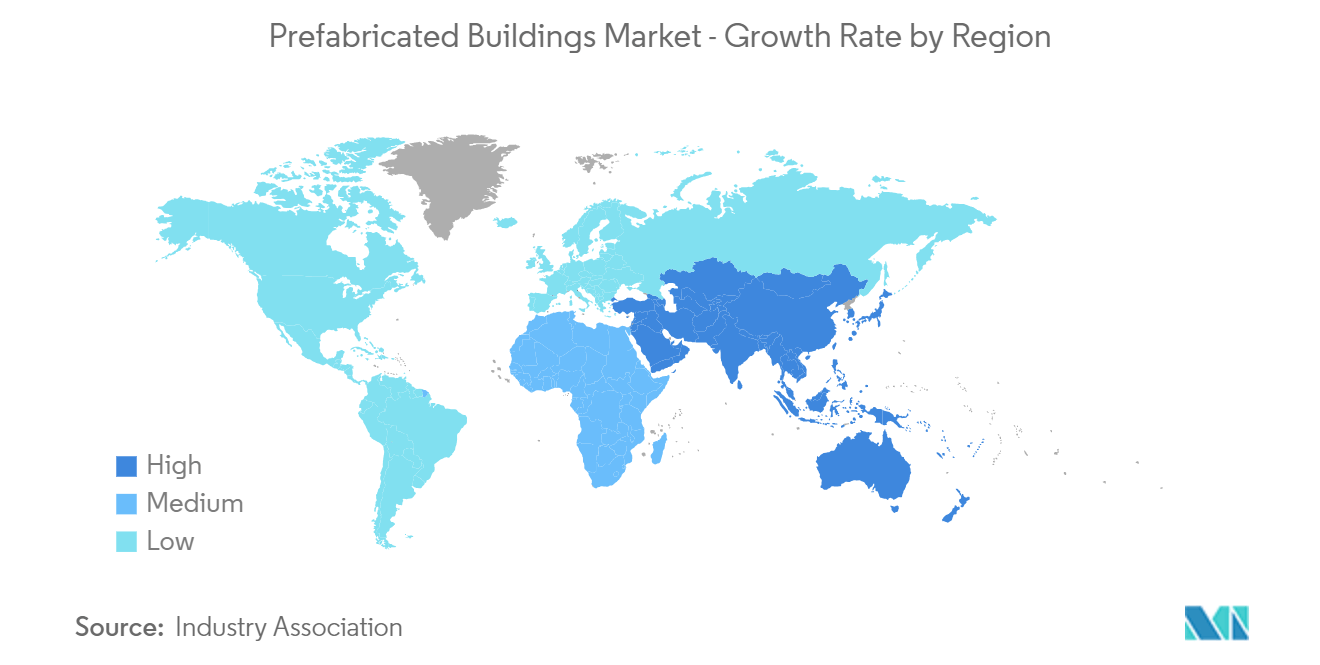
Competitive Landscape
The major companies in the prefabricated buildings industry are covered in this research. The market is fragmented, but it is likely to grow during the forecast period as prefab construction building investments and upcoming significant projects in various developing and developed countries increase. The major players include Clayton Homes, Sekisui Homes, China Saite Group Company Limited, PEAB, and Barratt Developments PLC.
Due to their efficiency, Prefabricated buildings are being used more and more frequently in recent years. This is not limited to housing either. The prefabricated buildings will also house restaurants, hotels, catering establishments, etc.
Prefabricated Buildings Industry Leaders
-
Clayton Homes
-
Sekisui Homes
-
China Saite Group Company Limited
-
PEAB
-
Barratt Developments PLC
- *Disclaimer: Major Players sorted in no particular order
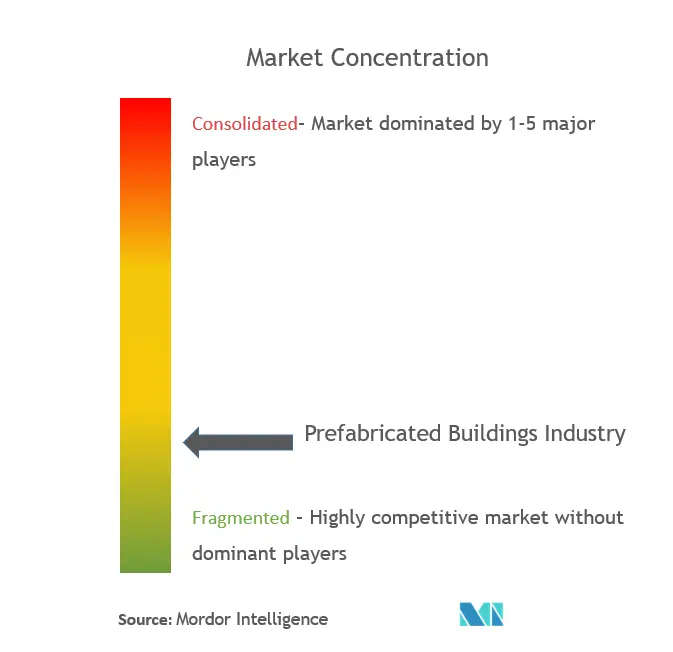
Recent Industry Developments
- September 2023: The city of Malmö in southern Sweden is set to welcome a new student housing project, Unity Malmö, comprised of 5 building blocks and 450 micro-living apartments, where Forta PRO delivered 269 modules, a total of 9,671.9 m2. Forta PRO is a world-leading modular construction company, providing advanced state-of-the-art solutions for the construction and expansion of apartments, healthcare solutions, hotels, student accommodation, rental apartments, and more with minimal disruption to the operations of surrounding facilities.
- February 2023: Modular Group Investments Ltd. (MGI) announced the acquisition of Oakland Glass Ltd. This is a key strategic addition to the Group, which adds significant capacity and capability in insulated double-glazed unit production and provides established routes to market for Oakland Glass through MGI’s existing and future channels.
Global Prefabricated Buildings Market Report Scope
A prefabricated building is a building or part of a building that has been manufactured in advance and can be easily transported and assembled.
The prefabricated buildings market is segmented by material type (concrete, glass, metal, timber, and other material types), application (residential, commercial, and industrial), and geography (North America, Europe, Asia-Pacific, and the Rest of the World).
The report offers market size and forecast in (USD) for the segments mentioned above.
| Concrete |
| Glass |
| Metal |
| Timber |
| Other Materials |
| Residential |
| Commercial |
| Industrial |
| North America | United States |
| Canada | |
| Mexico | |
| Europe | Germany |
| Italy | |
| United Kingdom | |
| Sweden | |
| Netherlands | |
| Spain | |
| Rest of Europe | |
| Asia-Pacific | China |
| Japan | |
| India | |
| Australia | |
| Indonesia | |
| Singapore | |
| Malaysia | |
| Rest of Asia-Pacific | |
| Rest of the World |
| By Material | Concrete | |
| Glass | ||
| Metal | ||
| Timber | ||
| Other Materials | ||
| By Application | Residential | |
| Commercial | ||
| Industrial | ||
| By Region | North America | United States |
| Canada | ||
| Mexico | ||
| Europe | Germany | |
| Italy | ||
| United Kingdom | ||
| Sweden | ||
| Netherlands | ||
| Spain | ||
| Rest of Europe | ||
| Asia-Pacific | China | |
| Japan | ||
| India | ||
| Australia | ||
| Indonesia | ||
| Singapore | ||
| Malaysia | ||
| Rest of Asia-Pacific | ||
| Rest of the World | ||
Key Questions Answered in the Report
How big is the Prefabricated Buildings Market?
The Prefabricated Buildings Market size is expected to reach USD 269.06 billion in 2025 and grow at a CAGR of 7.19% to reach USD 380.73 billion by 2030.
What is the current Prefabricated Buildings Market size?
In 2025, the Prefabricated Buildings Market size is expected to reach USD 269.06 billion.
Who are the key players in Prefabricated Buildings Market?
Clayton Homes, Sekisui Homes, China Saite Group Company Limited, PEAB and Barratt Developments PLC are the major companies operating in the Prefabricated Buildings Market.
Which is the fastest growing region in Prefabricated Buildings Market?
Asia-Pacific is estimated to grow at the highest CAGR over the forecast period (2025-2030).
Which region has the biggest share in Prefabricated Buildings Market?
In 2025, the North America accounts for the largest market share in Prefabricated Buildings Market.
What years does this Prefabricated Buildings Market cover, and what was the market size in 2024?
In 2024, the Prefabricated Buildings Market size was estimated at USD 249.71 billion. The report covers the Prefabricated Buildings Market historical market size for years: 2020, 2021, 2022, 2023 and 2024. The report also forecasts the Prefabricated Buildings Market size for years: 2025, 2026, 2027, 2028, 2029 and 2030.
Page last updated on:
Prefabricated Buildings Market Report
The prefabricated buildings industry report is segmented by material type, application, and geography. This industry analysis provides a comprehensive market overview, including industry statistics and market segmentation. The report offers insights into the market forecast and market growth, highlighting the industry trends and market trends that are shaping the industry's future.
In the residential, commercial, and industrial sectors, the report delves into the industry size and market size, providing a detailed industry profile and market profile. It also includes market predictions and market review, giving an in-depth look at the market outlook and industry outlook for the prefabricated buildings market.
The report covers various material types such as concrete, glass, metal, timber, and other materials, and provides industry information and market data relevant to these segments. The market value and industry value are analyzed, offering a thorough market analysis and industry research.
With a focus on different geographical regions, the report includes industry reports and market reports that highlight the growth rate and market leaders in North America, Europe, Asia-Pacific, and the Rest of the World. The report example and report PDF provide additional context and detailed findings.
The prefabricated buildings industry report aims to provide a complete picture of the market, including industry sales and market sales. The industry research and market research sections offer valuable insights into the industry's current state and future prospects. The research companies involved in compiling this report have ensured that it is a reliable source of information for stakeholders and decision-makers.
